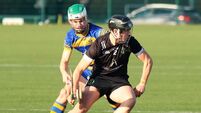A bridge too far for swan in flight?
Constructed in Holland, it had been hauled through heavy seas from Rotterdam.
The Samuel Beckett Bridge, which will link Guild Street, north of the Liffey, to Macken Street, on the south, had arrived. It was conceived in 1999; we have waited a long time for Godot to come. The barge could get through the narrow opening of the East Link drawbridge on the May high tide, but storms held up the operation for two days; with Godot, delays are only to be expected. Then, the weather improved and the birth was induced. The Dublin tug, Deilginis, was midwife, while a Dutch one played the expectant father, fussing nervously. The half-hour delivery was smooth and painless.
Designed by Santiago Calatrava, the Isambard Kingdom Brunel of our time, the 120-metre long carriageway will be suspended on 25 stay-wires from the giant spike, its tip 48 metres above the water. The Sam Beckett will have distinguished neighbours; Gandon’s Custom House, Kevin Roche’s conference centre, and Daniel Libeskind’s new theatre complex are all in its vicinity. The little Halfpenny Bridge, beloved of foreign television crews filing reports from Dublin, should be worried. Its days as the capital’s most celebrated viaduct may be numbered.
Consulting engineers, Roughan and O’Donovan, were worried that birds might collide with the structure, and, in January, 2000, they asked me to prepare a report for the oral hearing.
Birds of various species crash into cables, wind-turbine blades, windows and aircraft. Only swans are likely to hit the Sam Beckett. With eyes to the sides of the head, they have all-round vision, but can’t see what’s immediately in front of them.
The blind spot is not a problem in a natural environment. Swans seldom fly over land; they keep to watercourses, where the only obstacles are trees on river banks and the odd protruding cliff. Such objects are easy to spot. Some human artefacts are not.
Electricity cables spanning rivers are lethal.
Swans must fly fast to stay airborne. They are too heavy to change direction quickly, and by the time they see a cable ahead of them, it’s often too late.
A swan that banks or swerves may snag a wing on the wire, snapping the bones and sending the bird crashing down.
Of 1,487 swans ringed by me in the Dublin area, 196 (13%) were recorded flying into man-made structures. The actual number of collisions must be higher than this figure, because only a fraction of incidents come to light. The number of swan deaths, from all causes, up to the year 2000, was 357, but 30% resulted from collisions. Statistical analysis shows that slightly less than a third of all deaths were reported, so mortality is three times higher than the recorded figures.
Cables accounted for 73% of collisions, but bridges with protruding lamp standards, or other appendages, were also a hazard. Downed swans were reported on, or near, 18 bridges in the city and county, accounting for 9% of the collision total. A stayed cable bridge is more of a danger to swans than a conventional arched one, so will there be problems with the Sam Beckett?
Its location is fortunate; swans don’t breed downstream of the bridge site and there are no flocks in the vicinity. Some 84% of the swan movements recorded in the Dublin area began, or ended, in a flock and 42% of journeys were between flocks.
The lower Liffey is not on a route swans would take when moving between present flock locations.
Could swans move to a more vulnerable sites in the future?
Yes, but swans are conservative and set in their ways. The sites they choose are traditional.
Visibility is crucial in avoiding collisions. The thick, brightly-coloured stays of the new bridge will be conspicuous and spaced widely enough for a swan to fly between them. It’s impossible to eliminate all risk, but collisions should be few. Traffic in this area is slow-moving, and a swan coming down on the carriageway won’t endanger road users.














